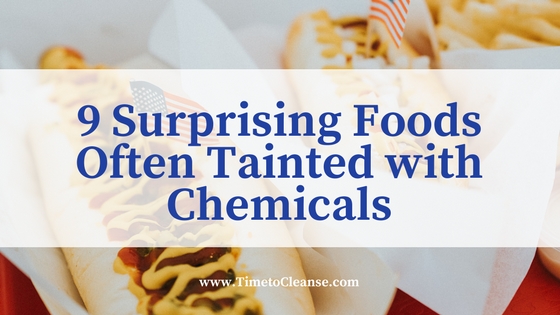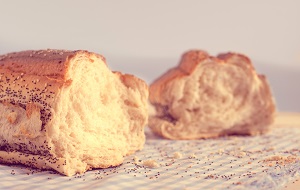
Modern lifestyles and toxins tend to go hand in hand, unfortunately, but you may be surprised by just how many chemicals might be present in the foods you eat. Even seemingly safe products, like bottled water, may have traces of contaminants that can be more harmful than good for your body. The following nine foods are ones many people may be surprised to find may be hiding some harmful chemical toxins.
Breads
 Many processed breads you find in the supermarket may contain a pesticide called glyphosate, which is the active ingredient in many bug sprays. Farmers may spray their wheat crops with the pesticide not only to keep bugs at bay but also to kill and dry the wheat for an easier harvest. Glyphosate has a possible link to cancer, even at the lowest levels. Choose organic bread to avoid the occurrence of the toxin.
Many processed breads you find in the supermarket may contain a pesticide called glyphosate, which is the active ingredient in many bug sprays. Farmers may spray their wheat crops with the pesticide not only to keep bugs at bay but also to kill and dry the wheat for an easier harvest. Glyphosate has a possible link to cancer, even at the lowest levels. Choose organic bread to avoid the occurrence of the toxin.
Quiz: Is Your Body TOXIC? Take the Test...
(get your free personalized report)
Peanut Butter
Peanut butter may be an excellent source of protein, but it also may potentially harbor aflatoxins. Since peanuts grow underground, they’re susceptible to fungus contamination, which may contain aflatoxins, a possible carcinogen to humans. When peanuts turn to peanut butter, the risk of aflatoxins lowers, but there still may be enough left over to cause harm.
Popcorn
Some popcorn is worse than others, but microwave popcorn can be especially harmful because its packaging process  introduces a plethora of contaminants. Additives help flavor the popcorn and cause its ability to pop correctly, and microwave popcorn bags even come with perfluorinated chemicals (PFCs) to ensure the popcorn doesn’t stick together or to the bag. Exposure to PFCs has been linked to liver issues, cancer, hormonal imbalance, and more.
introduces a plethora of contaminants. Additives help flavor the popcorn and cause its ability to pop correctly, and microwave popcorn bags even come with perfluorinated chemicals (PFCs) to ensure the popcorn doesn’t stick together or to the bag. Exposure to PFCs has been linked to liver issues, cancer, hormonal imbalance, and more.
Condiments
Mustard, ketchup, salad dressings, and relish are all condiments we recognize by their color easily. The reason they’re so recognizable, though, is because they’re often filled with food dyes that have no other effect on the condiment other than to give it a different color. Scientists continuously put food dyes under investigation for possible links to ADHD and other behavior problems in children.
Wrapped Cheese
Those single-slice cheeses wrapped in plastic may taste great on a sandwich, but the plastic wrapping may be harmful to your body. Cheese is a fatty food, and chemicals in plastic, like BPA and DEHA, love to leech their way into fat, making cheese the perfect host. It’s best to avoid cheese wrapped in plastic by ordering it from the deli in wax paper or slicing it yourself from a block of cheese.
Salmon
 Salmon may be one of the healthiest foods you can put in your body – unless you eat salmon with food coloring added to enhance its color. Some salmon farmers may feed a particular pigment, known as astaxanthin, to their salmon to give their flesh the beautiful coral color for which salmon is famous. Some locations require a “Color-Added” label on salmon to denote that it contains the additive.
Salmon may be one of the healthiest foods you can put in your body – unless you eat salmon with food coloring added to enhance its color. Some salmon farmers may feed a particular pigment, known as astaxanthin, to their salmon to give their flesh the beautiful coral color for which salmon is famous. Some locations require a “Color-Added” label on salmon to denote that it contains the additive.
Quiz: Is Your Body TOXIC? Take the Test...
(personalized report)
Pickles
One of the tastiest, crunchiest jarred foods around, pickles are a healthy snack made from different varieties of cucumbers and pickled to perfection. But, you may notice that pickles have a much different color than the pale green of cucumbers. That’s because the pickles you buy in the supermarket often have yellow dyes added to make them aesthetically pleasing. Researchers have linked some yellow dyes to cancer, developmental delays, and congenital disabilities.
Canned Tomato Products
Several canned products may be at risk of BPA contamination – the same chemical you worry about finding in plastic – but those with high acid content may be the most worrisome. Canned fruits, like pineapples and grapefruit, and tomato products, like tomato sauce or stewed tomatoes, are common culprits. Acid deteriorates the can’s lining, causing those harmful chemicals to seep into the contents. Opt for tomato products in glass jars instead.
Cereal
You like to think that cereal is a healthy breakfast option, but more and more cereal manufacturers are creating overly processed grains with unnecessary additives to make them more attractive to the average consumer. Many cereals are full of food dyes, including the harmful Red #40, known to cause severe allergic reactions in people. And, several contain BHT, a preservative that may have toxic effects on the lungs and the genotoxicity of other ingredients.
